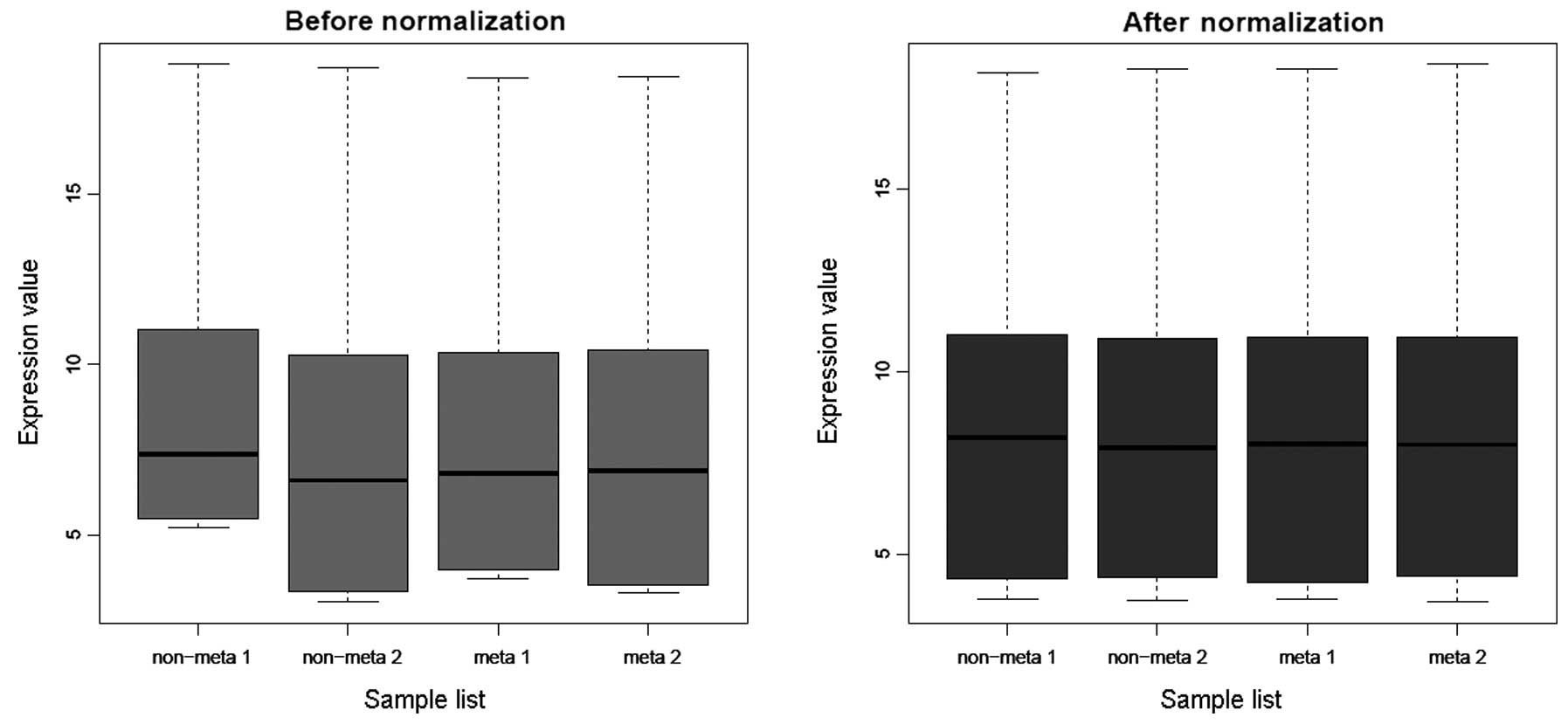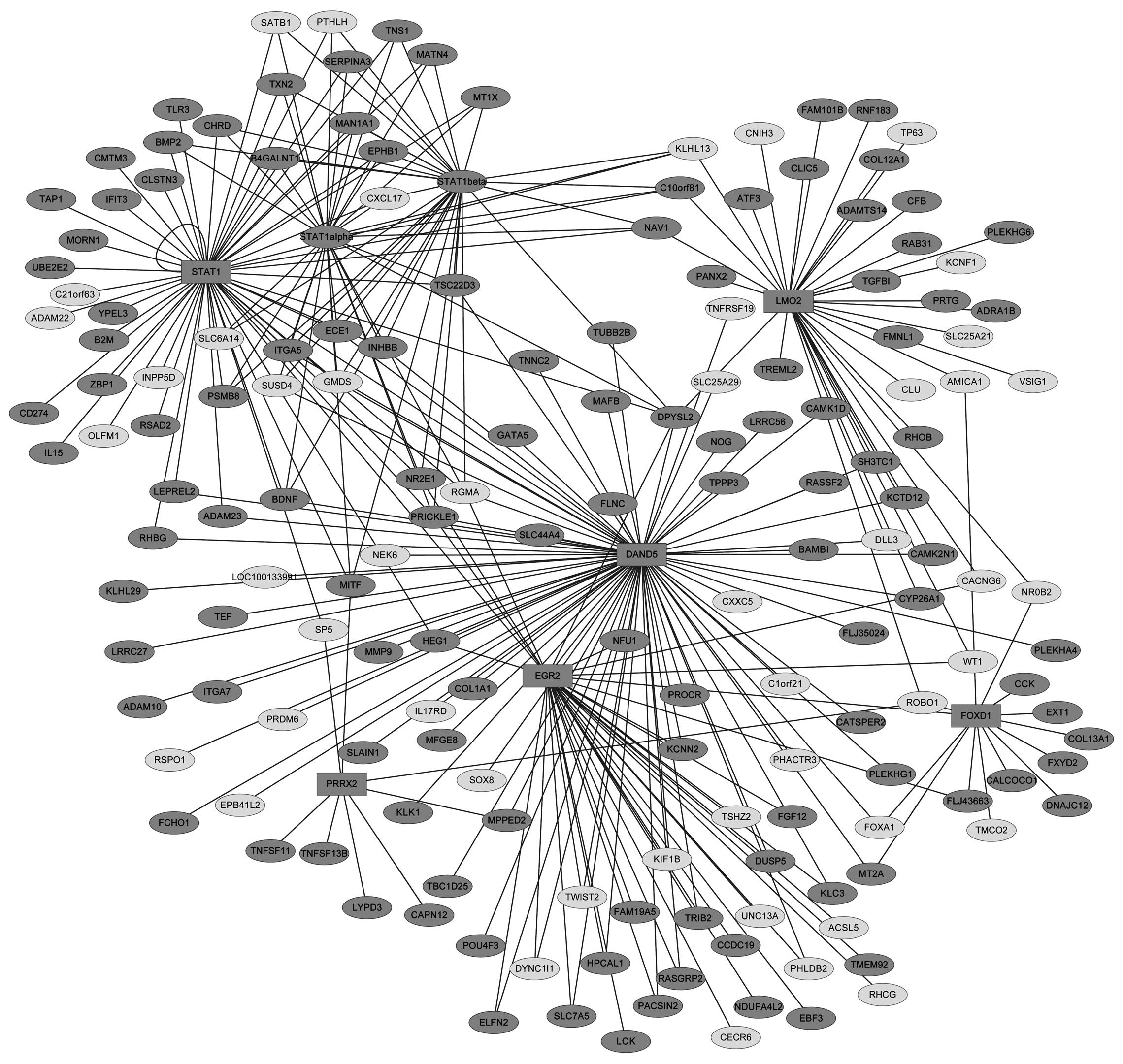|
1
|
World Health Organization. Cancer. Fact
sheet 297. WHO; Geneva, Switzerland: 2011
|
|
2
|
Yonemura Y, Endo Y, Fujita H, et al: Role
of vascular endothelial growth factor C expression in the
development of lymph node metastasis in gastric cancer. Clin Cancer
Res. 5:1823–1829. 1999.PubMed/NCBI
|
|
3
|
Shimizu K, Kubo H, Yamaguchi K, et al:
Suppression of VEGFR-3 signaling inhibits lymph node metastasis in
gastric cancer. Cancer Sci. 95:328–333. 2004. View Article : Google Scholar : PubMed/NCBI
|
|
4
|
Xu X, Abuduhadeer X, Zhang WB, et al:
Knockdown of RAGE inhibits growth and invasion of gastric cancer
cells. Eur J Histochem. 57:e362013. View Article : Google Scholar : PubMed/NCBI
|
|
5
|
Malafa M, Margenthaler J, Webb B, Neitzel
L and Christophersen M: MnSOD expression is increased in metastatic
gastric cancer. J Surg Res. 88:130–134. 2000. View Article : Google Scholar : PubMed/NCBI
|
|
6
|
Tang B, Peng ZH, Yu PW, Yu G and Qian F:
Expression and significance of Cx43 and E-cadherin in gastric
cancer and metastatic lymph nodes. Med Oncol. 28:502–508. 2011.
View Article : Google Scholar : PubMed/NCBI
|
|
7
|
Hippo Y, Taniguchi H, Tsutsumi S, et al:
Global gene expression analysis of gastric cancer by
oligonucleotide microarrays. Cancer Res. 62:233–240.
2002.PubMed/NCBI
|
|
8
|
Kang HC, Kim IJ, Park JH, et al:
Identification of genes with differential expression in acquired
drug-resistant gastric cancer cells using high-density
oligonucleotide microarrays. Clin Cancer Res. 10:272–284. 2004.
View Article : Google Scholar
|
|
9
|
Yamashita S, Tsujino Y, Moriguchi K,
Tatematsu M and Ushijima T: Chemical genomic screening for
methylation-silenced genes in gastric cancer cell lines using
5-aza-2′-deoxycytidine treatment and oligonucleotide microarray.
Cancer Sci. 97:64–71. 2006.PubMed/NCBI
|
|
10
|
Edgar R, Domrachev M and Lash AE: Gene
Expression Omnibus: NCBI gene expression and hybridization array
data repository. Nucleic Acids Res. 30:207–210. 2002. View Article : Google Scholar : PubMed/NCBI
|
|
11
|
Hatakeyama K, Ohshima K, Fukuda Y, et al:
Identification of a novel protein isoform derived from
cancer-related splicing variants using combined analysis of
transcriptome and proteome. Proteomics. 11:2275–2282. 2011.
View Article : Google Scholar
|
|
12
|
Gautier L, Cope L, Bolstad BM and Irizarry
RA: affy - analysis of Affymetrix GeneChip data at the probe level.
Bioinformatics. 20:307–315. 2004. View Article : Google Scholar : PubMed/NCBI
|
|
13
|
Smyth GK: Limma: linear models for
microarray data. Bioinformatics and Computational Biology Solutions
Using R and Bioconductor. Springer; New York: pp. 397–420. 2005,
View Article : Google Scholar
|
|
14
|
Eisen MB, Spellman PT, Brown PO and
Botstein D: Cluster analysis and display of genome-wide expression
patterns. Proc Natl Acad Sci USA. 95:14863–14868. 1998. View Article : Google Scholar : PubMed/NCBI
|
|
15
|
Page RD: TreeView: an application to
display phylogenetic trees on personal computers. Comput Appl
Biosci. 12:357–358. 1996.PubMed/NCBI
|
|
16
|
Huang da W, Sherman BT, Tan Q, et al: The
DAVID Gene Functional Classification Tool: a novel biological
module-centric algorithm to functionally analyze large gene lists.
Genome Biol. 8:R1832007.
|
|
17
|
Chan PP, Holmes AD, Smith AM, Tran D and
Lowe TM: The UCSC Archaeal Genome Browser: 2012 update. Nucleic
Acids Res. 40:D646–D652. 2012. View Article : Google Scholar : PubMed/NCBI
|
|
18
|
Kanehisa M and Goto S: KEGG: kyoto
encyclopedia of genes and genomes. Nucleic Acids Res. 28:27–30.
2000. View Article : Google Scholar : PubMed/NCBI
|
|
19
|
Shannon P, Markiel A, Ozier O, et al:
Cytoscape: a software environment for integrated models of
biomolecular interaction networks. Genome Res. 13:2498–2504. 2003.
View Article : Google Scholar : PubMed/NCBI
|
|
20
|
Nepusz T, Yu H and Paccanaro A: Detecting
overlapping protein complexes in protein-protein interaction
networks. Nat Methods. 9:471–472. 2012. View Article : Google Scholar : PubMed/NCBI
|
|
21
|
Prendergast G: Immune escape as a
fundamental trait of cancer: focus on IDO. Oncogene. 27:3889–3900.
2008. View Article : Google Scholar : PubMed/NCBI
|
|
22
|
Maehara Y, Tomisaki S, Oda S, et al: Lymph
node metastasis and relation to tumour growth potential and local
immune response in advanced gastric cancer. Int J Cancer.
74:224–228. 1997. View Article : Google Scholar : PubMed/NCBI
|
|
23
|
Atkins D, Ferrone S, Schmahl GE, Störkel S
and Seliger B: Down-regulation of HLA class I antigen processing
molecules: an immune escape mechanism of renal cell carcinoma? J
Urol. 171:885–889. 2004. View Article : Google Scholar : PubMed/NCBI
|
|
24
|
Cabrera T, Lara E, Romero JM, et al: HLA
class I expression in metastatic melanoma correlates with tumor
development during autologous vaccination. Cancer Immunol
Immunother. 56:709–717. 2007. View Article : Google Scholar
|
|
25
|
López-Nevot MA, Esteban F, Ferrón A,
Gutiérrez J, et al: HLA class I gene expression on human primary
tumours and autologous metastases: demonstration of selective
losses of HLA antigens on colorectal, gastric and laryngeal
carcinomas. Br J Cancer. 59:221–226. 1989.
|
|
26
|
Lee YS, Kim TE, Kim BK, et al: Alterations
of HLA class I and class II antigen expressions in borderline,
invasive and metastatic ovarian cancers. Exp Mol Med. 34:18–26.
2002. View Article : Google Scholar : PubMed/NCBI
|
|
27
|
Grünert S, Jechlinger M and Beug H:
Diverse cellular and molecular mechanisms contribute to epithelial
plasticity and metastasis. Nat Rev Mol Cell Biol. 4:657–665.
2003.PubMed/NCBI
|
|
28
|
Kaihara T, Kusaka T, Nishi M, et al:
Dedifferentiation and decreased expression of adhesion molecules,
E-cadherin and ZO-1, in colorectal cancer are closely related to
liver metastasis. J Exp Clin Cancer Res. 22:117–123.
2003.PubMed/NCBI
|
|
29
|
Nakata K, Ohuchida K, Nagai E, et al: LMO2
is a novel predictive marker for a better prognosis in pancreatic
cancer. Neoplasia. 11:712–719. 2009.PubMed/NCBI
|
|
30
|
Melino G: p63 is a suppressor of
tumorigenesis and metastasis interacting with mutant p53. Cell
Death Differ. 18:1487–1499. 2011. View Article : Google Scholar : PubMed/NCBI
|
|
31
|
Zhang Y, Sun R, Liu B, et al: TLR3
activation inhibits nasopharyngeal carcinoma metastasis via
down-regulation of chemokine receptor CXCR4. Cancer Biol Ther.
8:1826–1830. 2009. View Article : Google Scholar : PubMed/NCBI
|
|
32
|
González-Reyes S, Marín L, González L, et
al: Study of TLR3, TLR4 and TLR9 in breast carcinomas and their
association with metastasis. BMC Cancer. 10:6652010.PubMed/NCBI
|
|
33
|
Fang X, Cai Y, Liu J, et al: Twist2
contributes to breast cancer progression by promoting an
epithelial-mesenchymal transition and cancer stem-like cell
self-renewal. Oncogene. 30:4707–4720. 2011. View Article : Google Scholar : PubMed/NCBI
|
|
34
|
Li Y, Wang W, Wang W, et al: Correlation
of TWIST2 up-regulation and epithelial-mesenchymal transition
during tumorigenesis and progression of cervical carcinoma. Gynecol
Oncol. 124:112–118. 2012. View Article : Google Scholar : PubMed/NCBI
|
|
35
|
Ernst M, Najdovska M, Grail D, et al:
STAT3 and STAT1 mediate IL-11-dependent and inflammation-associated
gastric tumorigenesis in gp130 receptor mutant mice. J Clin Invest.
118:1727–1738. 2008.PubMed/NCBI
|
|
36
|
Khodarev NN, Roach P, Pitroda SP, et al:
STAT1 pathway mediates amplification of metastatic potential and
resistance to therapy. PLoS One. 4:e58212009. View Article : Google Scholar : PubMed/NCBI
|
|
37
|
Greenwood C, Metodieva G, Al-Janabi K, et
al: Stat1 and CD74 overexpression is co-dependent and linked to
increased invasion and lymph node metastasis in triple-negative
breast cancer. J Proteomics. 75:3031–3040. 2012. View Article : Google Scholar : PubMed/NCBI
|
|
38
|
Chen P, Zhao D, Sun Y, Huang L, Zhang S
and Yuan Y: Protein inhibitor of activated STAT-1 is downregulated
in gastric cancer tissue and involved in cell metastasis. Oncol
Rep. 28:2149–2155. 2012.PubMed/NCBI
|
|
39
|
Huang S, Bucana CD, Van Arsdall M and
Fidler IJ: Stat1 negatively regulates angiogenesis, tumorigenicity
and metastasis of tumor cells. Oncogene. 21:2504–2512. 2002.
View Article : Google Scholar : PubMed/NCBI
|
|
40
|
Park Y, Kim JW, Kim DS, et al: The bone
morphogenesis protein-2 (BMP-2) is associated with progression to
metastatic disease in gastric cancer. Cancer Res Treat. 40:127–132.
2008. View Article : Google Scholar : PubMed/NCBI
|
|
41
|
Kang MH, Oh SC, Lee HJ, et al: Metastatic
function of BMP-2 in gastric cancer cells: the role of PI3K/AKT,
MAPK, the NF-κB pathway, and MMP-9 expression. Exp Cell Res.
317:1746–1762. 2011.PubMed/NCBI
|
|
42
|
Matsui A, Yokoo H, Negishi Y, et al:
CXCL17 expression by tumor cells recruits
CD11b+Gr1high F4/80− cells and
promotes tumor progression. PLoS One. 7:e440802012. View Article : Google Scholar : PubMed/NCBI
|
|
43
|
Unoki M and Nakamura Y: EGR2 induces
apoptosis in various cancer cell lines by direct transactivation of
BNIP3L and BAK. Oncogene. 22:2172–2185. 2003. View Article : Google Scholar : PubMed/NCBI
|
|
44
|
Nakahara Y, Shiraishi T, Okamoto H, et al:
Detrended fluctuation analysis of genome-wide copy number profiles
of glioblastomas using array-based comparative genomic
hybridization. Neuro Oncol. 6:281–289. 2004. View Article : Google Scholar
|
|
45
|
Wu Q, Jin H, Yang Z, et al: MiR-150
promotes gastric cancer proliferation by negatively regulating the
pro-apoptotic gene EGR2. Biochem Biophys Res Commun. 392:340–345.
2010. View Article : Google Scholar : PubMed/NCBI
|
|
46
|
LaTulippe E, Satagopan J, Smith A, et al:
Comprehensive gene expression analysis of prostate cancer reveals
distinct transcriptional programs associated with metastatic
disease. Cancer Res. 62:4499–4506. 2002.
|
|
47
|
Li Y, Wang W, Wang W, et al: Correlation
of TWIST2 up-regulation and epithelial-mesenchymal transition
during tumorigenesis and progression of cervical carcinoma. Gynecol
Oncol. 124:112–118. 2012. View Article : Google Scholar : PubMed/NCBI
|
|
48
|
Li J, Ye L, Kynaston HG and Jiang WG:
Repulsive guidance molecules, novel bone morphogenetic protein
co-receptors, are key regulators of the growth and aggressiveness
of prostate cancer cells. Int J Oncol. 40:544–550. 2012.
|
|
49
|
Zhao ZW, Lian WJ, Chen GQ, et al:
Decreased expression of repulsive guidance molecule member A by DNA
methylation in colorectal cancer is related to tumor progression.
Oncol Rep. 27:1653–1659. 2012.PubMed/NCBI
|














